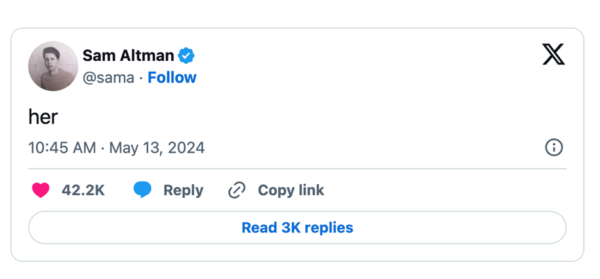You’d think that a new company with the resources of OpenAI would have a straightforward path to building trust. They had no legacy brand problems to unwind, no historical scandals to overcome, and no CEO constantly planting foot into mouth. Until recently.
OpenAI, the company behind ChatGPT, seems determined to avoid the straightforward path to trust. Sheesh — it’s almost as if they’re trying to sabotage the brand.
Here’s the latest example: When the company launched new voice models with GPT-4o last week, many people noted how much the one called Sky sounded like Scarlett Johansson, who voiced the AI assistant in the 2013 movie Her. Before the launch event, OpenAI CEO Sam Altman published a one-word post on X that said simply, “her.”

Scarlett Johansson revealed that OpenAI had asked to license her voice. She declined the offer twice — once when originally asked a year ago and again a few days before the product’s release. The company says it hired a different actress. Yet the result eerily echoes Johansson’s original performance. Cue the potential lawsuits and bad press for OpenAI’s brand.
But that’s just one inconvenient event. Or is it? See also: The departure of several high-profile employees charged with protecting humanity, the restrictive clauses in OpenAI employment contracts, plus Altman’s claim he didn’t know about the clauses despite his signature on some of the documents.
Declining returns from the attention economy
The OpenAI vs. Scarlett Johansson beef is only the latest example of how the attention economy has reached peak valuation.
For years, marketers have tried a range of things to attract audience and buyer attention. On one end of the spectrum, you have the art and science of attempting to manipulate algorithms for visibility in search and social media. On the other end, you have “rage-baiting” — a tactic that involves stoking outrage to increase content engagement.
Some liken attention to a currency. Now, its value is waning compared with a much more powerful rival — trust.
Brand trust rises in importance
As the old saying goes, trust is the hardest thing to find and the easiest thing to lose. And trust is in deep crisis worldwide.
The 2024 Edelman Trust Barometer intro highlights the challenge OpenAI and other tech companies face. The authors wrote:
“Rapid innovation offers the promise of a new era of prosperity, but instead risks exacerbating trust issues, leading to further societal instability and political polarization.”
Put simply: Trust in companies, media, and government erodes as leaders value attention over trust. Governmental politicians stoop to high-school-level insults; business leaders say outrageous things to stay in the press; and marketing departments bend over backward for that short-term sugar high of the click.
Ignore this decline of trust at your peril. Developing and demonstrating a trustworthy relationship with consumers is now one of the most important things marketers must do.
And that’s not new. But it’s clear that people no longer start out trusting and then become disappointed. The Edelman study points out that “most institutions are not trusted to introduce innovations to society.”
The media is actively distrusted. Governments and NGOs barely break 50% in terms of the number of people who trust them to integrate innovation into society (50% and 54%, respectively).
Yup. Distrust is democratized into everything.
Ick.
There is some good news. Edelman found that businesses have the highest level of trust (64%) among all institutions.
As a side note: Your brand is probably more trusted than the media company you’re paying to advertise with. That might be the strongest argument for an owned media strategy in 2024.
Attention is water, trust is the reservoir
What if your brand could become not only the most trusted on a topic among your competitors but the most trusted brand, period?
If that were the goal, would you trade some attention (say traffic or engagement) for fewer but more meaningful content interactions?
Historically, marketers looked at trusted information publishers and proclaimed, “There’s no way we can compete with that magazine (or nonprofit, association, or governmental agency).”
And you were right — those publications and organizations had all the attention.
But, if trust is the valued metric, you can compete now. And you must.
Trust as a metric
I worked with a B2B financial services company targeting investors and advisors a few years ago. The company asked a sample of its target audience to rank the institution and its competition on a level of trust. We also asked them to rank a sampling of the top media companies in the space.
At that time, comparing trust in financial services brands to trust in media brands was like comparing apples and oranges. But to reach its “increase brand trust” goal, the team set a goal for its new portfolio to become one of the most trusted content brands for financial advisors and investors.
When they repeated the ranking exercise a couple of years later, the team found wonderful results. The brand had risen in trust among both its competitors and media companies. That’s wonderful from a brand recall perspective.
But even more interesting were the results segmented from the brand’s subscribed audiences. Many of those who subscribed to the brand’s content trusted the company more than any other competitor and media companies.
These results provide a huge business case for the value of their content approach: Developing a deeper, more trusted relationship with audiences than even some of their media partners had.
It was a slower build and possibly more expensive to acquire a subscriber than a lead. But it paid off in a more valuable customer relationship — loyalty.
Playing the short, long game of trust
In the trust economy, value accrues when an audience trusts the brand and shares, evangelizes, and draws more people to that trust.
The short-term game of attention used to be the fastest way to show value in marketing. The goal was to distribute the most innovative thing, the most differentiated opinion, or the catchiest slogan to persuade potential buyers at the exact moment they need something.
But that game is only winnable when you start from a position of trust. Of course, you can’t earn trust without first having someone’s attention. The need for attention isn’t gone.
But now, you need to earn trust (by delivering value) in the first moments after you’ve earned the attention.
Yup. Marketing in the trust economy is harder.
You’ve got to demonstrate trustworthiness better, faster, and consistently. It’s the short, long game of a modern marketing strategy.
Gathering attention just doesn’t cut it anymore. Holding attention doesn’t work that well, either. You can hold someone’s attention for a bit without making them care.
The opportunity is here. The democratization of distrust can transform what’s possible. Your content can turn your brand into the most exciting and trusted resource for your customers.
It’s up to you to be worthy of the trust and the opportunity.
It’s your story. Tell it well.
HANDPICKED RELATED CONTENT:
Cover image by Joseph Kalinowski/Content Marketing Institute

